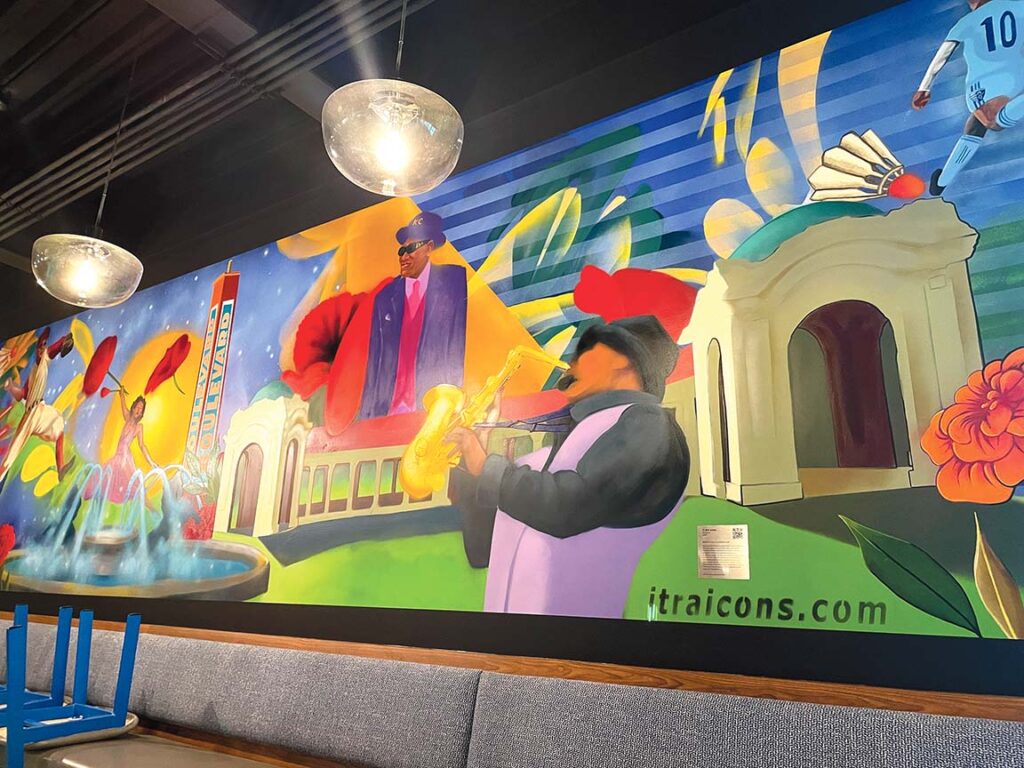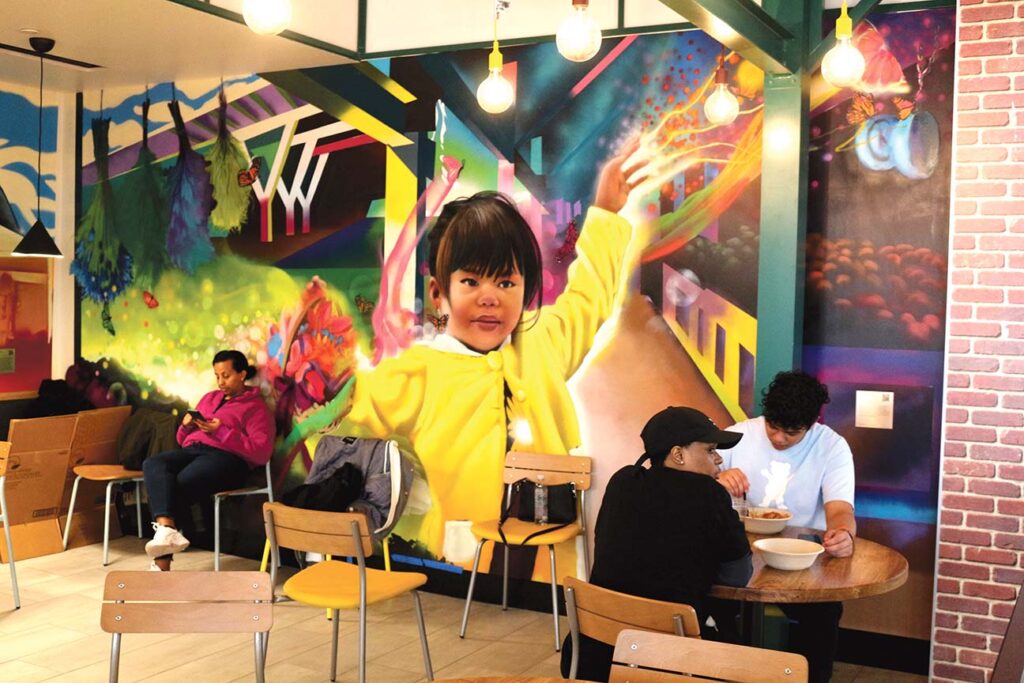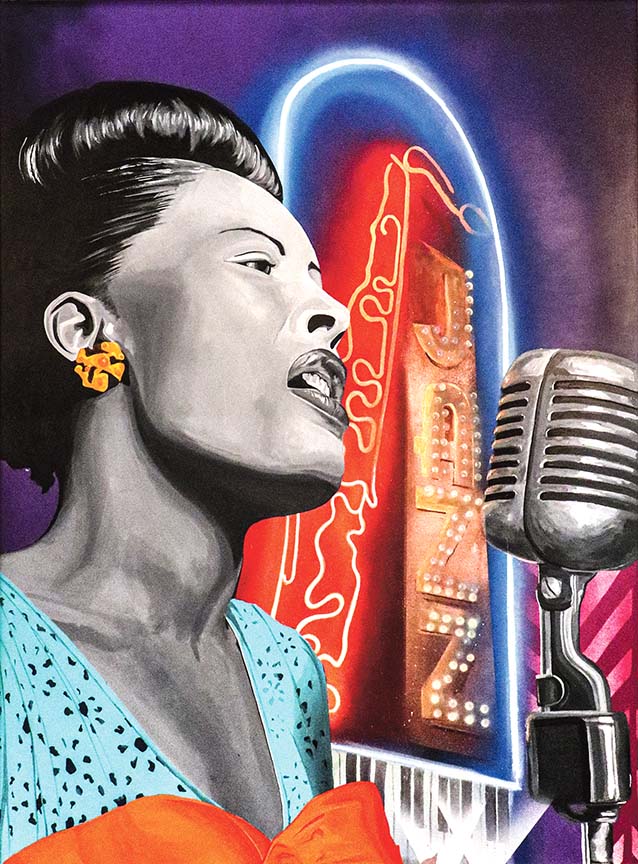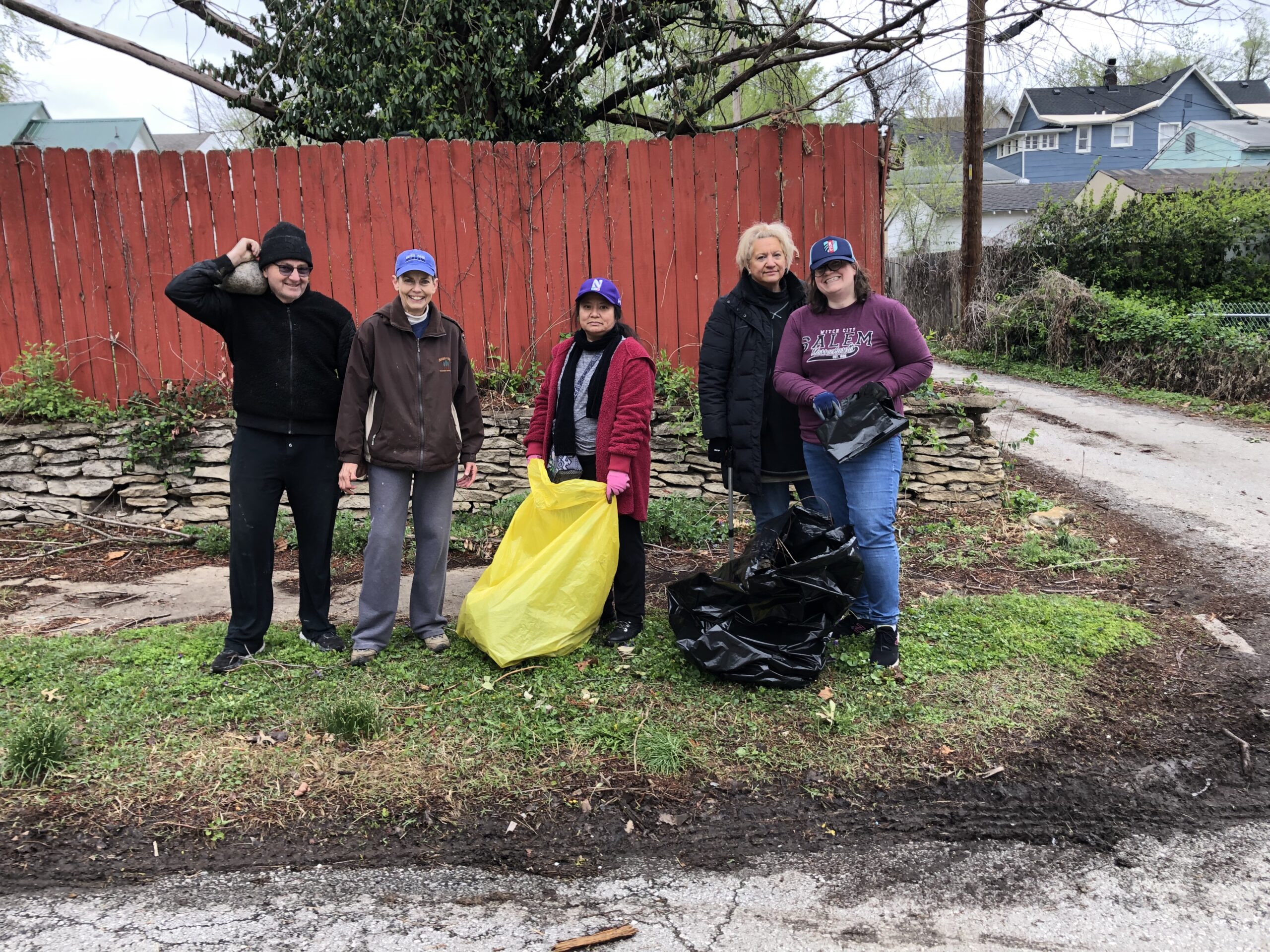
Abby Hoover
Managing Editor
Northeast Kansas City-based muralists Rodrigo Alvarez and Isaac Tapia dream of creating art internationally. They’ll soon have an audience from around the world with their recently completed murals in the Kansas City Airport’s (MCI) new terminal.
“Our murals aim to tell different stories from the community, and the airport mural collection certainly reflects Kansas City through our lens,” they told the Northeast News.
Tapia and Alvarez grew up in the Historic Northeast and attended Paseo Academy of Fine and Performing Arts. Both children of immigrants, Alvarez and Tapia were DACA (Deferred Action for Childhood Arrivals) recipients and first-generation students. However, they didn’t start working together until much later.
Years later, the partnership, IT-RA Icons, took flight, evolving into a full-fledged art business. The pair is taking a non-traditional path to pursue their passions of art and small-business ownership. Recently, they were selected to paint nine murals in the new terminal.
IT-RA Icons worked with the concessions team at the new terminal, creating murals for restaurant areas.
The first mural, just past security outside the Made of KC Food Hall that houses Bloom Baking Co., Jay “Hootie” McShann’s Blues Bar, Pigwich and Poío, incorporates the city’s history of Jazz, fountains and sports, with iconic landmarks like Union Station and the Bartle Sky Stations, which extend above the city’s convention center.
They weren’t provided a lot of direction – aside from no politics and no nudity – because the people they were working with were either from Chicago or St. Louis.
“This is the last one that we did,” Alvarez said. “Initially, they had asked us to design two different spaces, one for Soirée, one for Made of KC. Then once we started it, they just said, ‘Let’s spread out. You have one out facing one. You have to make this one larger.’ And then they added more murals and more stuff.”

Two years ago, the pair initially wanted to apply for the Municipal Art Commission’s 1% For Art program, which selected 19 artists to create installations in the airport terminal.
“We wanted to apply for that, and at that time, we were painting one of our first really big murals, and we completely forgot to send in our application – like we had put everything together – but we forgot,” Tapia said. “That day, Rico was out there ‘til like six in the morning.”
That 180-foot mural in Okun Fieldhouse at the Mid-America Sports Complex in Shawnee had them adding final details and putting on a clear coat into the early morning hours on their last day with the lifts.
So, they missed the deadline. But soon, they got a call from Silhouette Design Architecture, who was designing the concessions spaces.
“We have been lucky enough to work with a lot of local restaurants that are actually here,” Tapia said. “I feel like that’s how the connection was made. We’ve worked with Martin City, Poío, River Market – I don’t know if there’s any other ones that we’ve worked with – they kind of recommended us, so that’s how we got connected with them.”
Building a new airport terminal was not a quick process. After the initial communication, IT-RA Icons would go months without hearing from them.
But on December 15, 2022, things started happening. The airport team requested they work at night, out of the way of construction crews, and threw them a curveball – they could only use brushes, not spray paint – and they handed them three additional murals, benches and a two-month deadline.
They got to work in Soirée Steak & Oyster House, a staple of the 18th and Vine District, first. With the help of a few interns, they completed the three framed panels with detailed brush strokes.
The pair said they don’t paint in the same styles – they can point out who did what on each mural – but their work blends well together.
“It’s cool because there’s play and there’s contrast in styles, which makes the piece even more interactive for everyone because everyone likes different things,” Alvarez said. “So you can never hit all of them as a single artist, but having everyone else painting differently does bring an element of, I don’t know, different textures, layers of talent.”
Their plans for the Soirée murals were very detailed, as they were done using only brushes. Sometimes three artists would be working on one small panel at once.
“I think what it came down to was it was more of, like, a signing,” Tapia said. “Like, ‘You paint this, you paint that, you paint that.’ I guess that’s how, and as long as everybody’s following the design and following, ‘Okay, this has to look like this, or close to this,’ then it was fine.”
The American Jazz Museum, located in the 18th and Vine District, curated the displays of Kansas City’s Jazz history on the walls surrounding their murals.
“I think they captured the sense of the Jazz District 100%,” said Soirée Executive Chef Anita Moore. “I couldn’t be more happier with it.”
She hopes a visit to Soirée at the airport encourages people to visit 18th and Vine.
“That’s my primary goal is when they come see this and they come visit Kansas City, they automatically want to just drive down there,” she said.
The new Kansas City International Airport will continue to welcome visitors from across the world, be a stop on trips across the country, and send Kansas Citians off on new adventures.
Alvarez and Tapia don’t know how to feel about all those people seeing their work – at least not yet. Now that they’ve got a second to rest, they’re imagining all the eyes that will be laid on their work.
“I’m just now thinking about it because for the past few months, I’m just thinking, ‘We’ve got to finish. We got to finish,’” Tapia said. “So I don’t know how to feel yet. Right now, it’s exciting, and hopefully, people get to know Kansas City a little bit more. It’s not just, like, farms.”
For Alvarez, there’s a little bit of anxiety attached to it.
“We are in the airport,” Alvarez said. “Like, five years ago, we’re like, ‘We’ll paint that food truck, screw it. That dumpster? You want trash in that dumpster but you want it to look pretty? We’ll paint it, whatever it is.’ And now we’re at the airport.”

As the only mural artists at the airport, they know their work will probably be seen by muralists from around the world.
“The anxiety of them seeing our work, being international as it is, and falling short, you know, how the artist in everyone is like, ‘Is it good enough? You know, can we play with the big dogs?’” Alvarez said. “We want to fly to Mexico and do a mural, or Uruguay, or Europe, anywhere, but I don’t know. For me it’s a little bit of anxiety of like, ‘How do we measure up?’”
Alvarez and Tapia will have been partners for six years in November. Tapia was three years behind Alvarez in school, but knew his brother from middle school at J.A. Rogers.
In high school, Alvarez created sculptures.
“I never really got to talk to him until [we were] out of high school,” Tapia said. “Because one day I was like, ‘Yo, that’s a cool picture, can I paint it?’ And that’s kind of kind of how it started again. Then one day he got to visit my studio under some apartments that I was in at that moment.”
“We had a wonderful conversation about immigration,” Alvarez said.
Their first project, purely by chance because another artist fell through, was at the Kansas City Public Schools’ Richardson Early Learning Center. Alvarez’ sister, who works for the district, recruited him, although his preferred medium was metal sculpting.
“I have this little, tiny, half-inch brush, and I’m just trying to do stuff, and I had just visited with Isaac a few weeks earlier,” Alvarez said. “I was like, ‘Hey, would you like to do a mural?’ And then from there on, we just did that one, they called us back and we did a second one at the same space, and we just kept going.”
After that, they went all over Northeast, knocking on doors and trying to get more walls. They did one at a now closed check cashing place by Price Chopper, international flags at Northeast High School – which they look back on to remember how far they’ve come – and a few in River Market.
At first, they didn’t know how to charge for a mural. On one of their early projects, they ended up making $1.50 per hour.
“We knew that in order to keep it going, we had to just do whatever came our way,” Tapia said.
They lost count of their projects at 60, and now their work can be found all over the metro.
Alvarez and Tapia didn’t know each other while they were growing up just blocks apart in Northeast Kansas City, but shared many of the same experiences.
“I mean, it was cool,” said Tapia, who grew up at 8th and Chestnut. “There wasn’t a lot of what’s going on right now where the streets were being cleaned up and all of that, it was a little bit more rough, I think.”
One of the things he remembers was walking with his dog all the way up Chestnut, past the little lake, and down Cliff Drive to the waterfall.
“So that’s what I remember the most, we used to take walks around that area all the time,” Tapia said. “Cliff Drive, that area is what I remember the most, and my favorite area as well. That’s why I kind of wanted to put a little bit of Cliff Drive in one of the murals.”
Alvarez had a lot of negative experiences, but there were also a lot of good.
“Northeast, like, we’ve been there for 20 years, and whatever it is that you went through there just doesn’t like to cast a shadow over how rich it is, as far as cultural makeup,” Alvarez said. “Yeah, I’ve gotten shot at, seen stabbings, I’ve seen shootings when people die. I’ve seen all of that in Northeast. But I have also seen a whole bunch of people go out of that same neighborhood and do some great things. This guy here, my siblings are doing amazing. So I don’t think it’s the environment, it’s how close your community is. Northeast is definitely strong.”
Tapia immigrated to the United States at the age of nine, and lived in the same house at Ninth and Bennington for many years.
“I haven’t known any other places besides this area, I guess,” Tapia said. “If I do go outside the area right now, it’s more depressing to me to go outside the area than being where I am just because of all the cultures that are in there now. Especially the food, there’s so many different foods. We like to eat and so we’ve gone to almost every restaurant that’s in the Northeast.”
Their favorites right now are Sambusas from Yasmine Café at Independence Avenue and The Paseo, or Los Altos de Jalisco on St. John.
Alvarez, whose wife is also from the neighborhood, bought a house outside of Northeast six years ago. While his neighbors were friendly, they missed the diversity.
“I feel like you can’t find a more diverse place in KC, other than the Northeast area,” Alvarez said. “I think that’s where you get the most diversity, and also my wife is like hardcore Northeast. So she was born there and she will never go anywhere else.”
Although Tapia’s parents recently moved out of the neighborhood, they both still have family in Northeast.
They incorporated the iconic Colonnade at Concourse Park into their mural inside Made of KC. So many people they know took photos for quinceañeras or weddings there, including Alvarez.
The Colonnade is surrounded by marigolds, a flower that holds much meaning in their culture.
“We also wanted to represent more of who we are, where we come from,” Tapia said.
Each year, the Kansas City Museum’s annual Day of the Dead celebration is decorated with thousands of marigolds, which are thought to attract the souls of the dead to the altars prepared for them.
The airport projects were very intensive. After initial planning and design, they spent almost eight hours a day, every day for two and a half months painting. They would arrive in the afternoon and stay through midnight or 1 a.m.
“When they proposed this artwork for the concession stands, they did so in a group setting with a whole bunch of contractors and subcontractors, so on, so forth,” Alvarez said. “And once the city approved it then they were like, ‘Okay, let’s go to work on constructing it,’ But we played broken phone for like a year, year and a half, without hearing anything. When we designed these, they were in different settings, because they themselves didn’t know what sizes the murals would be.”
They had to redesign and track down more supplies throughout the process.
“We were also used to spraying, and so they didn’t let us use spray paint at first, and then we were like, ‘Can we paint at night and maybe we can use spray paint?’ and they were like ‘Yeah,’ and so the first mural that we did paint, at Soirée, it took us about two and a half weeks,” Tapia said.
All brush murals take longer, and are much more detailed.
In Stockyard Brewing, IT-RA Icons has a mural dedicated to Kansas City sports – the Royals, the Chiefs, Sporting KC and the Current.
The City Market Food Hall murals, surrounded by the fresh flavors of Bo Ling’s, Taste of Brazil, Pigwich, Boulevard Brewing and Buffalo State Pizza Co., tell the story of Black farmers, immigrants from across the world and fresh, locally grown food.
The little girl featured on the mural is Alvarez’ friend’s daughter. His family, who is Vietnamese, has worked in the City Market for years. His daughter is not a U.S. citizen, but he’s working on it, and when she finally flies into Kansas City, she’ll see herself on the wall.
Alvarez said he never saw painting as an outlet until the opportunity was presented. He still creates sculptures and has come to love painting murals.
“It’s definitely more accessible, easier,” Alvarez said. “You can paint anywhere. You can just sit down here on this floor, and just paint something, plop down and just go to town. But for welding, it’s a lot more intensive.”
Tapia has always been a painter. In high school, he worked in oil paint, and thought he’d never want to do murals.
“I wanted to do portraiture, and I specifically wanted to do portraiture because of one of my favorite artists, John Singer Sargent,” Tapia said. “But then the whole thing with Rico came up, and before that I had done a little bit of spray painting with one of my friends, and so that’s kind of how I tried it. I was like, ‘Maybe I do want to do this’ and then Rico was like, ‘But we gotta do this!’”
Tapia painted with Jose Faus, a local artist – , during his time at the Kansas City Art Institute, and as he saw murals start popping up around Kansas City.
“They have to be Jose Faus’ murals, the first ones that I ever saw, and especially making that connection with actually helping him out in painting,” Tapia said. “That was for me, later on in life, what would actually propel me to start making more.”
IT-RA Icons have work all over Kansas City and beyond, and with the new airport terminal opening this week, they’ll have their work on an international stage.
For more information about their projects, visit itraicons.com.















